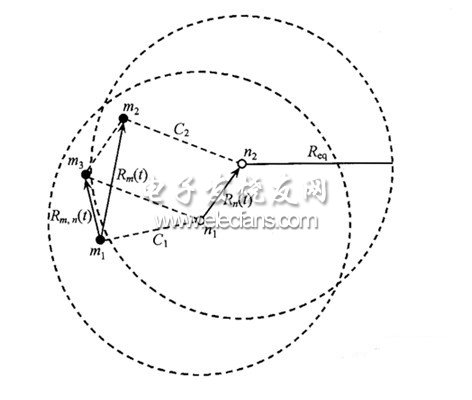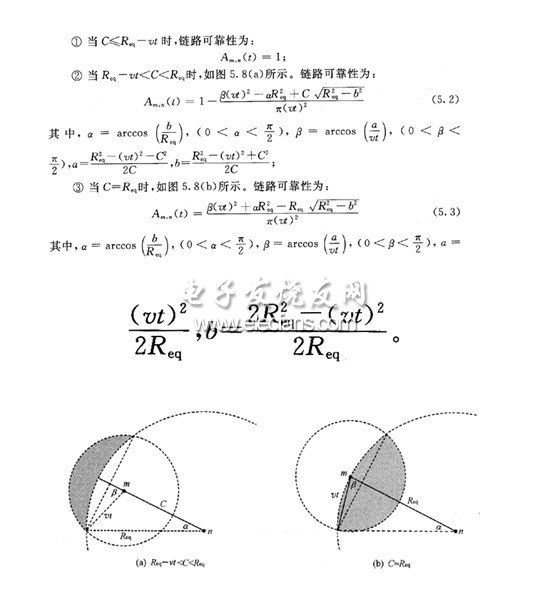The link reliability model is based on the random removal model. In the random removal model, the movement process of a node consists of a series of random lengths of time periods, which are called movement epochs. During a period of time, the node's speed and direction of motion remain unchanged. The motion properties of the node are determined by three parameters: λn, μn, and σ2n. The following is the definition of these three parameters and related assumptions:
①The length of the motion period TIn follows the exponential distribution with the parameter λn.
② The node motion velocity Vin in the motion cycle is a random variable with mean μn variance σ2n.
③ Node movement direction θin in the motion cycle; obey the uniform distribution in (0, 2π).
④ Movement speed Vin, movement direction bream and movement cycle length θin are mutually independent.
⑤ The motion of the node is not related, and the failure of the link is independent.
For the motion between two nodes, we can select one of the nodes as a reference point, and use the relative displacement of the other node to represent the motion relationship between the nodes, as shown in the figure. The initial positions of the two nodes in the graph are m1 and n1, and the distance between them is C1; after the time lapse, the positions of the two nodes are m2 and n2, the mutual distance is C2, and their random movement vector is Rm ( t) and Rn (t). If the node n is used as the reference point, the position of the node relative to the node n is m3 after time t, and the relative random movement vector of the node solution with respect to the node knife is: Rm, n (t) = Rm (t)-Rn ( t), the relative velocity between two nodes can be expressed as:

Figure The relative motion relationship of two nodes

If the relative movement speed of node m and node n at time t0 is v, then at time t, the movement range of node m relative to node n can be represented by a circle with radius vt. According to the distance C between node m and node n at time t0 (C≤Req, Req is the maximum radius of the moving range), the link reliability can be divided into three cases:

Figure 2 Link reliability of Ad Hoc network
In view of the unreliability of communication links between Ad Hoc network nodes, this chapter improves on the basis of the AD0V protocol and obtains an Ad Hoc network routing protocol based on link reliability: LRBA (link reliability based AODV) In the routing process, the most reliable path can be selected as the route according to the link status, thereby greatly reducing the impact of unreliable routing on the routing protocol and improving the quality of communication. In order to obtain the reliability of the link, a field for storing node coordinate information has been added to the RREQ, RREP, and HELLO groups. After receiving these messages, other nodes can use formulas (5, 1), (5.2), (5.3) Perform link reliability calculations and select routes or update routing tables based on the results.
The following are the processing steps after the node receives the RREQ packet:
Step1: It is judged that the apricot is repeated, and Step2 is not repeated; otherwise, the RREQ is destroyed and transferred to Step8;
Step2: Update the routing request table, go to Step3;
Step3: Obtain the node coordinate information in RREQ, obtain the historical information of the nodes in the neighbor list, calculate the link reliability, go to Step4;
Step4: Update the entries in the neighbor table and routing table that reach the source node, go to Step5;
Step5: When reaching the destination node, go to Step7, otherwise go to Step6;
Step6: Look up the routing table, find the route to the destination node, go to Step7, otherwise go to Step8;
Step7: Construct RREP unicast to the last hop node, destroy RREQ, go to Step9;
Step8: Update the node coordinate information in RREQ, broadcast RREQ, and go to Step9;
Step9: Return.
The following are the processing steps after the node receives the RREP packet:
Step1: Determine whether to repeat, and do not repeat Step2, otherwise destroy RREQ and transfer to Step9;
Step2: Update the routing request table, go to Step3;
Step3: Obtain the node coordinate information in RREP, obtain the historical information of the nodes in the neighbor list, calculate the link reliability, go to Step4;
Step4: Update the entries in the neighbor table and routing table that reach the source node, go to Step5;
Step5: Go to Step6 if you reach the destination node, otherwise go to Step7;
Step6: Update the routing table, destroy RREP, and go to Step9;
Step7: Look up the routing table, find the reverse route to the destination node and go to Step8, otherwise destroy RREP and go to Step9;
Step8: Update the node coordinate information in RREP, forward RREP and go to Step9;
Step9: return
Guangzhou Winson Information Technology Co., Ltd. , https://www.winsonintelligent.com